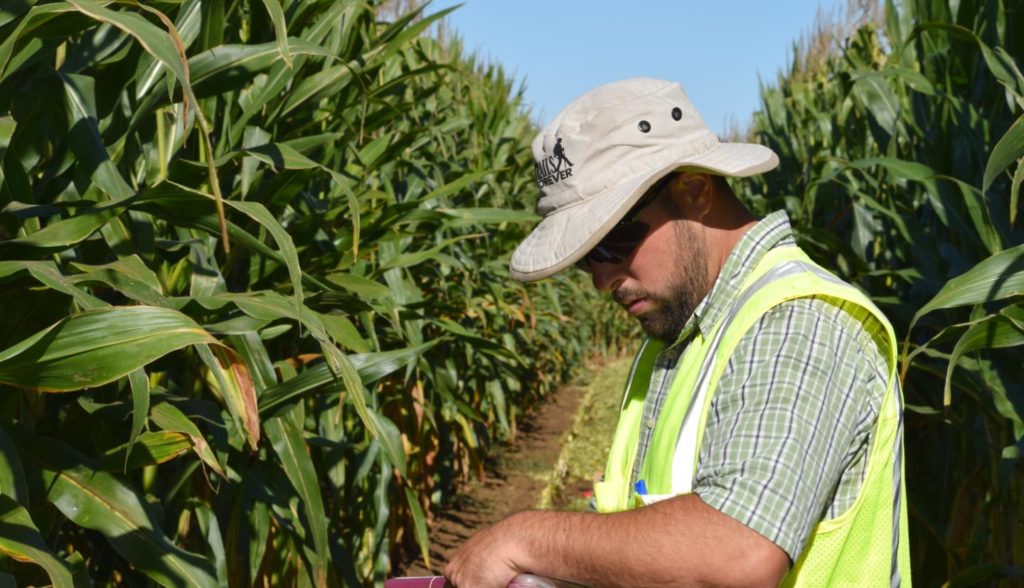NY VT Corn Silage Program Enhances Purchasing Power for Farmers
A seed company can assure you of the quality of their product, but how do you evaluate those claims? The NY-VT Corn Silage Program acts as a third-party to evaluate these products and to help farmers make informed decisions.

Joe Lawrence in a cornfield. Image provided
Joe Lawrence is the Dairy Forage System Specialist for Cornell CALS Department of Animal Science PRO-DAIRY. Here he provides insight into the research and extension work accomplished by PRO-DAIRY to evaluate the quality of feeds available on the market for dairy farmers. Specifically, his work is part of a larger joint project between New York (represented by extension specialists at Cornell CALS) and Vermont (represented by extension specialists at the University of Vermont).
What is the New York-Vermont Corn Silage Program?
The idea behind the NY VT Corn Silage Program is to offer third-party evaluation of corn hybrids, giving farmers greater insight into the quality of these products. There are numerous agricultural companies that sell seeds. Each has protocols to develop and internally test performance of their hybrids available on the market for farmers.
Each winter we send out requests to seed companies to test their products. Companies pay an entry fee for each hybrid to cover analysis and labor costs, knowing that the data from the studies will be made available to the public. All results are open source for farmer and seed companies alike.
How many companies have participated in the trials in 2021?
This year we tested 61 hybrids from 12 different brand names. The most participation we ever had was 90 hybrids from 16 different brand names. This year we experienced a dip in participation since many companies had lowered their budgets for scientific testing due to the coronavirus. Trends in the seed industry such as the consolidation of companies has also lowered the number of brands available to the public.
How do you account for testing so many different hybrids with specialized growing needs?
We split up the seeds into two different groups – those that have a short growing season and those that have a long growing season. Both groups are planted in two distinct locations in New York State with different growing conditions. The seeds are evaluated against those that are most similar to them, which provides more accurate results that farmers can use to make purchasing decisions.
Can you speak to the collaboration between Cornell and the University of Vermont (UVM)?
Yes, this arrangement has been one of the major contributors to the growth the program. Cornell takes entries for all the growing locations in New York and UVM agrees to grow the same hybrids at a site in Vermont to assess the seeds’ performance in different climates and agricultural conditions. Their team plants and collects data throughout the growing season, adding to the diversity of growing conditions each hybrid is tested in. Testing multiple conditions affords the best data possible.
What are some key findings from the 2021 NY VT Corn Silage Program?
Overall, it was a good growing season. It started off quite dry in May and June, but as rain increased as the season went on, the crops seemed to withstand the change and produced high yields. Forage quality is also really important for silage production, even more so than grain. We try to emphasize that our focus is on the quality of the forage that farmers feed their animals. In this case we prioritize quality along with yield, which means we take a unique approach to feed analysis.
Tom Overton, department chair and professor in Cornell CALS Department of Animal Science and program director for PRO-DAIRY and Mike Van Amburgh, professor in Cornell CALS Department of Animal Science developed a novel approach using the Cornell Net Carbohydrate and Protein System (CNCPS) to evaluate milk production of a cow consuming our feed samples.
The NY and VT corn silage evaluation program is made possible with support from dairy producers, participating seed companies, Cornell University, the University of Vermont, the New York Corn Growers Corn Research and Education Program, and the Cornell University Agricultural Experiment Station.

